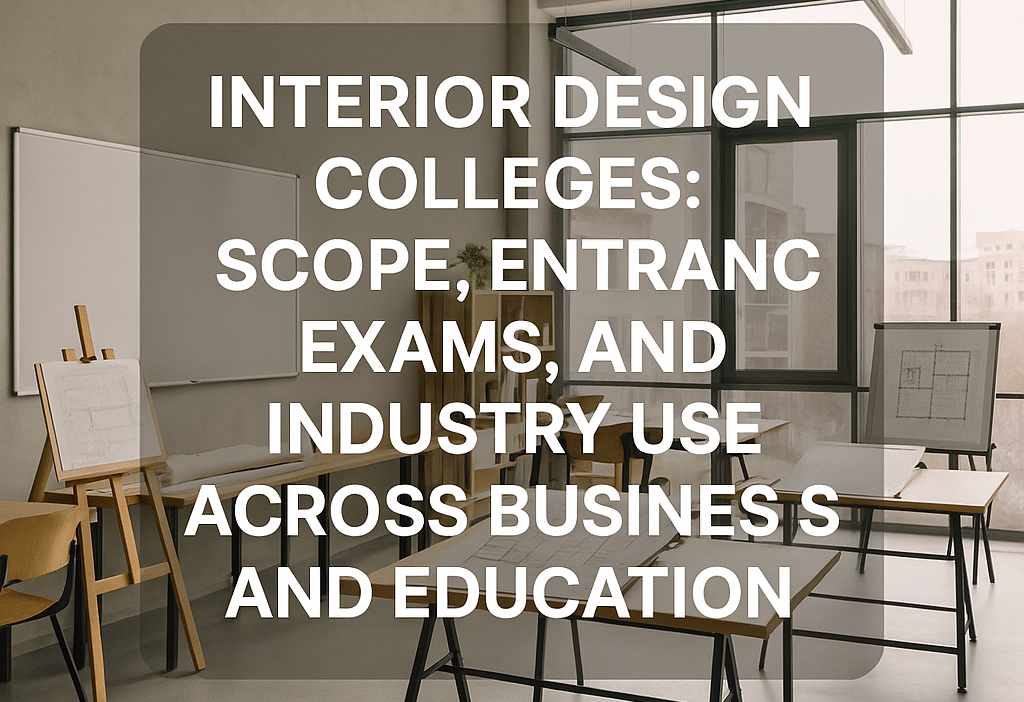Interior design is no longer limited to decorating homes — it has become a multidisciplinary field shaping how we live, work, and interact with our surroundings. With the growing demand for thoughtful, functional, and sustainable spaces, more students are now exploring interior design colleges as a starting point for a creative and impactful career.
Whether you’re planning to prepare for an entrance exam for interior designing or simply exploring your options, understanding the scope, opportunities, and real-world applications of interior design is essential.
Why Choose Interior Design as a Career?
Interior design goes beyond just style and aesthetics. It’s about understanding human behavior, space functionality, and material applications to create environments that improve quality of life. From commercial spaces and retail stores to educational institutions and healthcare, interior designers play a crucial role in shaping experiences.
If you’re someone who enjoys creativity, problem-solving, and visual storytelling, interior design can be a great fit.
Suggestions for Students Considering Interior Design
Before you choose a college or course, here are a few helpful tips:
- Explore your interests: Interior design includes furniture design, lighting, materials, spatial planning, sustainability, and even tech integration. Know your strengths and curiosity areas.
- Research interior design colleges: Look for colleges with updated curricula, industry exposure, hands-on studios, and strong mentorship. Locations like Delhi-NCR, Pune, Mumbai, and Bengaluru have some of the most forward-thinking institutes.
- Prepare for the entrance exam for interior designing: Most reputed colleges conduct entrance tests that assess creativity, spatial understanding, drawing skills, and basic awareness. Institutes may also require a portfolio or interview.
- Focus on portfolio development: Start building a portfolio that reflects your thinking process, ideation, and experimentation. It doesn’t have to be perfect — it just needs to show your potential.
Scope and Opportunities After an Interior Design Degree
The scope for interior designers is expanding rapidly, especially as people and companies begin to understand the importance of good design. From luxury residences to small retail spaces, every business now needs interiors that reflect their identity and serve a function.
Here are some popular career paths after graduating from interior design colleges:
- Residential Interior Designer
- Commercial Space Planner
- Furniture or Lighting Designer
- Exhibition and Event Space Designer
- Set Designer for film/TV
- Retail and Hospitality Designer
- Sustainable Design Consultant
- Interior Stylist or Visual Merchandiser
Additionally, many interior design graduates also work in interdisciplinary fields such as experience design, product design, or creative direction. Some start their own studios, while others work with architecture firms, consultancies, or design-led startups.
Interior Design in Various Industries
Interior design is not limited to the traditional design world — it touches many industries in unique ways. Let’s look at how this skill is applied across sectors:
1. Business & Retail
In business environments, interior design helps shape customer experiences, employee productivity, and brand identity. Retail stores, showrooms, and cafes depend on designers to create spaces that invite people in and support business goals.
2. Education
Modern schools and colleges are rethinking their learning spaces. Designers work closely with educators to create classrooms, libraries, and campuses that improve student engagement and comfort.
3. Healthcare
Interior designers play a key role in planning hospitals, clinics, and wellness centers that are both functional and comforting for patients and staff. Factors like lighting, materials, and layout become critical.
4. Hospitality & Travel
Hotels, resorts, and even airports rely on interior designers to create immersive experiences that blend functionality with storytelling. Every detail — from the reception desk to guest room decor — is carefully crafted.
5. Real Estate & Architecture
Interior designers often collaborate with architects and real estate developers to plan spaces in residential complexes and commercial buildings. Their insights improve the usability and market appeal of a property.
6. Event and Exhibition Design
From pop-up shops to museum exhibits and trade shows, temporary spaces also need creative spatial solutions — and that’s where interior design skills shine.
Trends Driving Interior Design Today
The world of interior design is continuously evolving. Here are some trends shaping the future of the field:
- Sustainable and eco-friendly design: More designers are using recyclable materials and energy-efficient systems.
- Minimalist and functional spaces: Designs that use fewer elements while serving multiple purposes are gaining popularity.
- Smart interiors: Integration of technology such as voice-controlled lighting or automated furniture is rising.
- Biophilic design: Bringing nature indoors through greenery, natural light, and organic materials improves well-being.
- Cultural storytelling: Interiors that reflect local art, heritage, or craft traditions are becoming increasingly important, especially in hospitality and luxury projects.
Final Thoughts: Is Interior Design the Right Path for You?
Choosing a design career is not just about drawing or decoration — it’s about changing the way people experience the world. Interior design allows you to combine creativity with strategy, and aesthetics with function.
If you’re passionate about spaces, have a keen eye for detail, and enjoy observing how people interact with their environment, enrolling in a reputed interior design college could be the beginning of a very rewarding journey. Just remember to prepare well for the entrance exam for interior designing, build a strong portfolio, and stay open to learning beyond the classroom.
Interior design is not just a career — it’s a mindset. One that constantly adapts, innovates, and improves the spaces we live in.



